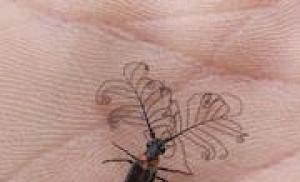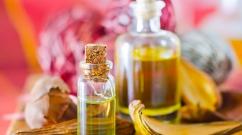Kingdom of mushrooms. General characteristics, structural features, nutritional method, cell structure, storage substances, types of reproduction, higher and lower mushrooms
Spare parts: in eumycetes, glucose is stored in the form of alpha-glucan (close to glycogen), and oomycetes in the form of beta-glucan (close to laminarin); trehalose oxaccharide; sugar alcohols; lipids (in the form of fat droplets). Nutrition(osmotrophic) is largely associated with plants, therefore, fungi secrete enzymes for the destruction of pignin (pectinase, xylonase, cellobiase, amylase, lignase) and the destruction of ether bonds in cutin wax (cutylase).
Cleavage products enter the cells in three types: 1. Dissolved (due to turgor pressure of hyphae) 2. Passive (along the gradient of substance concentration) 3. Actively (using special protein transporter molecules) Environmental groups... According to trophic and topical characteristics.
Topically: soil (red boletus (Leccinum aurantiacum), real camelina (Lactarius deliciosus)) and water (mucor - on the surface, camposporiums - underwater structures)
The role of mushrooms in nature.
Destruction of polymers, Fixation of biophilic elements in the mushroom mass, Soil formation, Transformation of N, P, K, S and others into substances available for minimal plant nutrition, Creation of enzymes and biologically active substances in the soil, Destruction of rocks and minerals, Formation of minerals, Participation in food chains, Regulation of the structure of the community and its size, Detoxification of pollutants (substances that can harm human health or the environment), symbiosis with plants and animals.
The value of mushrooms for humans.
Usage: Biotechnology, producers of antibiotics, producers of immunomodulators, anticancer, hormonal, anti-sclerotic, chitin - burn and wound healing, high adsorption, destruction of biopolymers (enzymes), food industry (clarification of juices), production of organic acids, release of phytohormones, food and feed (yeast , basidium), biological pesticides, plant mycorrhization.
This group of organisms was previously referred to as plants. At present, mushrooms, numbering about 120 thousand species, are isolated into an independent kingdom, since in a number of biological properties they differ from bacteria, plants and animals.
Fungal cells, unlike bacteria, are eukaryotes. They are distinguished from plants by the absence of chlorophyll and the use of ready-made organic matter for nutrition, that is, by the type of nutrition they are heterotrophs. The reserve nutrient in fungi is glycogen, not the starch found in most plants. By the way of feeding (absorption) and unlimited growth, mushrooms approach plants. What brings them closer to animals is that urea is involved in the metabolism. Fungi are also characterized by the formation of a pronounced cell wall, reproduction by spores, immobility in a vegetative state, etc.
The classification of fungi is based on the methods of reproduction and features of morphology.
The kingdom of mushrooms Mycetalia, Fungi, Mycota is divided into two kingdoms: lower mushrooms (Myxobionta) and higher mushrooms (Mycobionta).
Lower fungi are characterized by the presence of rudimentary as well as unicellular mycelium. These include the fungi of the Myxomycota division with the Myxomycotina subdivision, which unites the Phycomycetes class (phycomycetes) - aquatic fungi.
The phycomycete class includes about 700 species of mushrooms. Phycomycetes have a well-developed unicellular non-septate (not having septa) multinucleated mycelium. Mushrooms of this class are subdivided by an order of magnitude Mucorales, the Misogaseae family, which unites the main genera Mucor, Rhizopus and Thamnidium, which are the causative agents of defects (spoilage) of dairy and other products.
The higher fungi include spore-forming yeast, as well as fungi characterized by multicellular mycelium. Cells have one nucleus, many have two or more.
The sub-kingdom of higher fungi includes the department of true (real) mushrooms (Eumycota), the subdivision of true mushrooms (Eumycotina), which unites three classes: Fungi imperfecti).
Ascomycetes class (from lat. ascus- bag + Greek. myces - mushroom) unites more than 30 thousand species. A characteristic feature for the whole class is sexual sporulation and the presence in cells (bags) usually of 8 endogenous spores (ascospores), sometimes 4 or 2. The ascomycete class includes the order Endomycetales, which includes the Endomycetaceae family, which includes nonmycelial, unicellular, spore-forming fungi called yeasts, in particular those of the genus Saccharomyces. This yeast is used in the manufacture of bread, wine, beer, alcohol, etc. Spore-forming yeast also includes the dairy yeast of the Saccharomyces lactis and S. casei species.
Basidiomycete class (from the Greek. basidion- small base, foundation + myces- mushroom) unites more than 20 thousand species of fungi with a developed septic mycelium. The main organ of sporulation in them is cudgel-like structures - basidia (homologue of asuka). Primary (haploid) mycelium develops from basidiospores, which, as a result of the fusion of hyphae, gives a secondary (diploid) mycelium with fusion of nuclei, i.e., sexual reproduction begins.
The class of imperfect mushrooms includes more than 25 thousand mushrooms that do not have sexual sporulation. They have a developed multicellular mycelium. This class also includes non-spore-forming yeast.
The absence of a sexual cycle in imperfect fungi forces researchers to classify mushrooms in orders, families, and genera only on the basis of morphology. Therefore, several classifications have been proposed for mushrooms of this class.
By the nature of conidial sporulation, the class of deuteromycetes is divided into several orders, among which the most important are Hyphomycetales fungi (from the Greek. hyphe- fabric + myces - mushroom) and Protoascales (protoascale mushrooms). The order of filamentous fungi includes the Moniliaceae family, which includes the genera of molds Aspergillus, Penicillium, Cladosporium, Alternaria, Catenularia, as well as the mildew mold Geotrichum (Oidium, Endomyces) lactis, which are frequent causative agents of defects in dairy products.
The kingdom of eukaryotes includes the kingdoms of plants, animals and fungi.
1. Plants - autotrophs, make organic substances for themselves in the process of photosynthesis. Animals and fungi are heterotrophs; ready-made organic matter is obtained from food.
2. Animals are able to move, but grow only before the start of reproduction. Plants and fungi do not move, but they grow indefinitely throughout life.
3. Differences in the structure and work of the cell
- Only plants have plastids and a large central vacuole.
- Only animals have a cell center (centrioles) and no cell wall.
- The storage carbohydrate in plants is starch, and in animals and fungi it is glycogen. The cell wall of plants is composed of cellulose (cellulose), while in fungi it is made of chitin.
Tests
1. Mushrooms differ from plants in that
A) have a cellular structure
B) incapable of active movement
C) are incapable of photosynthesis
D) grow throughout life
2. What features of the vital activity of fungi indicate their similarity with plants
A) the use of solar energy in photosynthesis
D) the release of oxygen into the atmosphere
3. Organisms with a heterotrophic diet, which cannot move, belong to the kingdom
A) plants
B) animals
C) mushrooms
D) bacteria
4. What features of the vital activity of fungi bring them closer to plants
A) absorption of organic matter from the soil
B) unlimited growth throughout life
C) synthesis of organic substances from inorganic
D) use of ready-made organic substances in food
5. What are the similarities between fungi and multicellular animals
A) absorb nutrients from the entire surface of the body
B) feed on ready-made organic substances
C) are autotrophs by way of nutrition
D) have unlimited growth
6. The reserve nutrients in mushrooms include
A) glycogen
B) proteins
C) fats
D) starch
7. Organisms, whose cells have chloroplasts, belong to the kingdom
A) animals
B) plants
C) mushrooms
D) bacteria
8. Both animal and plant cells have
A) core
B) vacuoles with cell sap
C) chloroplasts
D) a shell of fiber
9. Eukaryotes with autotrophic feeding belong to the kingdom
A) animals
B) plants
C) bacteria
D) mushrooms
10. In the process of life, plants use organic substances that they
A) absorb from the air
B) is absorbed from the soil
C) obtained from other organisms
D) create themselves in the process of photosynthesis
11. Mushrooms differ from plants in that they
A) grow throughout life
B) contain ribosomes in cells
C) by the way of nutrition - heterotrophic organisms
D) absorb water and mineral salts from the soil
12. Select plant traits
A) autotrophs, can grow all life
B) autotrophs, grow only before the start of reproduction
C) heterotrophs, can grow all life
D) heterotrophs, grow only before the start of reproduction
13. Select the signs of animals
14. Choose the signs of mushrooms
A) autotrophs, can grow all life
B) autotrophs, grow only before the start of reproduction
C) heterotrophs, can grow all life
D) heterotrophs, grow only before the start of reproduction
15. Choose the signs of mushrooms
16) Select plant traits
A) there is a solid cell wall, storage substance glycogen
B) no solid cell wall, storage substance glycogen
B) there is a solid cell wall, starch storage substance
D) no solid cell wall, starch storage substance
17. Select the signs of animals
A) there is a solid cell wall, storage substance glycogen
B) no solid cell wall, storage substance glycogen
B) there is a solid cell wall, starch storage substance
D) no solid cell wall, starch storage substance
Currently, there are about 100,000 species of fungi described, but according to some estimates, there may be about 1.5 million.
Taxonomy
Kingdom of Mushrooms
Mushroom subkingdom
Subkingdom Real mushrooms (do not form motile cells at any stage of the life cycle)
Department of Zygomycetes (belong to the lower fungi)
Department of Ascomycetes, or Marsupial mushrooms
Department of Basidiomycetes
Department of Deuteromycetes (Imperfect Mushrooms)
The body of the mushroom consists of long filaments - hyphae.
The hyphae grow apically (apex) and can branch out, forming a dense interwoven network - mycelium, or mycelium.
The mycelium is located in the substrate (soil, wood, living organism) or on its surface.
The growth rate of mycelium depends on environmental conditions and can reach several centimeters per day.
In basidiomycetes, the mycelium is often perennial, in other fungi it is annual. Since the mycelium grows apically, its growth is centrifugal. The oldest part of the mycelium in the center gradually dies off and the mycelium forms a ring. In addition, some fungi secrete substances that inhibit plant growth (amensalism), and the vegetation cover forms rounded "bald spots".
Rice. "Witch's Ring"
TYPES OF MYCELIUM
- non-cellular (non-septic) mycelium: formed by one multinucleated giant cell (for example, in zygomycetes);
- cellular (septate) mycelium: there are intercellular septa (septa); cells are mononuclear or multinucleated. Vopenings can remain in the cell partitions through which the cytoplasm and organelles (including nuclei) freely flow from cell to cell.
Ascomycetes dikaryotic mycelium(consists of binucleated cells).

Rice. Mycelium: 1 - unicellular (non-septic); 2 - multicellular (septate); 3 - dikaryotic (yeast).
Fruiting bodies of basidiomycetes are formed by false tissue plectenchyma(pseudoparenchyma), consisting of densely intertwined mycelium hyphae. Plectenchyma, in contrast to the ordinary parenchyma, is formed not by three-dimensionally dividing cells, but by the strands of hyphae.
Hyphae are able to unite into long strands - rhizomorphs(Old Greek - root-like form): the outer cells of the cord are denser and perform a protective function, the inner more delicate cells perform a conductive function.


Rice. Rhizomorphs
For the transfer of unfavorable conditions, many mushrooms form dense rounded bodies formed by a plexus of hyphae - sclerotia(Old Greek - hard). Outside, the sclerotia are covered with a hard dark membrane that protects the inner light tender hyphae containing nutrients. Germinating, sclerotia give rise to mycelium; sometimes a fruiting body is immediately formed from them.

Rice. Ergot sclerotia
Sclerosis
FUNCTIONS OF GIF (MYCELIUM):

Physiology of fungi
EATING MUSHROOMS
According to the sources of organic matter used, mushrooms are divided into 4 groups.
Molecules of organic substances that make up living organisms and their residues cannot pass through the cell wall of fungi, therefore, fungi secrete digestive enzymes into the substrate. These enzymes break down organic matter to low molecular weight compounds that the fungus can absorb on its surface (osmotrophic type of nutrition).This is how it happens external digestion mushrooms.
- Predatory mushrooms: actively catch prey with the help of modified hyphae (trapping loops, etc.).
- Symbiotic mushrooms: enter into symbiosis with various autotrophic organisms (lower and higher plants), receiving organic substances from them, and in return supply them with mineral nutrition.
SYMBIOSIS
- Mycorrhiza (fungus root): symbiosis of fungi with the roots of seed plants.
Since the area of absorption of the hyphae of fungi is much larger than the area of the absorption zone of the roots, the plant receives much more minerals, which allows it to grow more actively. The plant, in turn, gives the fungus part of the carbohydrates, the products of photosynthesis.

Rice. Mycorrhiza
SYMBION MUSHROOMS

REPRODUCTION OF MUSHROOMS
Asexual reproduction:
- multicellular and unicellular parts of the mycelium
- sporulation
endogenous spores (sporangiespores) are formed in sporangia
exogenous spores (conidiospores = conidia) form in conidia - budding (in yeast)

Rice. Sporulation of molds: conidia of penicillus (a) and aspergillus (b); sporangiospores mucor (c)
Sexual reproduction:
Real fungi do not have mobile cells, so the fusion of the cells of two individuals occurs through the growth and convergence of hyphae.
- fusion of gametes formed in gametangia (isogamy, heterogamy, oogamy);
- somatogamy: fusion of two cells of the vegetative mycelium;
- gametangiogamy: fusion of two reproductive structures not differentiated into gametes;
- hologamia: fusion of cells of unicellular fungi.
In addition to asexual sporulation, in fungi, sexual sporulation also occurs: the formation of spores by meiosis after the fusion of the genetic material of gametes or nuclei.


Rice. Mukor and his sporangium
REPRODUCTION OF FLOUR
Department of Ascomycetes (Marsupials)
- About 30,000 species.
- Saprotrophic soil and mold fungi that settle on bread, vegetables and other products.
- Representatives: penicillus, yeast, morels, lines, ergot.
- The mycelium is haploid, septate, branching. Through the pores, the cytoplasm and nuclei can pass into neighboring cells.
- Asexual reproduction using conidia or budding (yeast).
- During sexual reproduction, bags (asci) are formed, in which haploid spores of sexual sporulation are formed during meiosis.
YEAST
Yeast is represented by a large number of species that are widespread in nature.
One-celled or two-celled fungi, the vegetative body of which consists of mononuclear oval cells.
Different types of yeast can exist in diploid or haploid phases.
Yeast is characterized by an aerobic metabolism. They use various sugars, simple and polyhydric alcohols, organic acids, and other substances as a carbon source.
The ability to ferment carbohydrates, breaking down glucose to form ethyl alcohol and carbon dioxide, served as the basis for the introduction of yeast into culture.
WITH6 N12 O6 C6H12O6 → 2 WITH2 N5 ON 2С2Н5ОН + 2 WITHO2 2CO2
Yeast reproduces by budding and sexually.
Under favorable conditions, yeast multiplies for a long time in a vegetative way - by budding. A kidney occurs at one end of the cell, begins to grow and separates from the mother cell. Often, the daughter cell does not lose its connection with the mother cell and itself begins to form kidneys. As a result, short cell chains are formed. However, the connection between them is fragile, and when shaken, such chains break up into individual cells.
With a lack of nutrition and an excess of oxygen, sexual reproduction occurs: two cells merge to form a diploid zygote. The zygote divides by meiosis to form a bursa with 4 ascospores. The spores coalesce to form a new diploid yeast cell.

Rice. Yeast budding and sexual reproduction.
Outwardly, it resembles black-purple horns (sclerotia) protruding from an ear. They are composed of tightly intertwined hyphae.

Rice. Ergot
LIFE CYCLE OF SPORGNA
The binucleated mycelium forms fruiting bodies, known as cap mushrooms.

Rice. The structure of cap mushrooms
On the underside of the cap there is a spore-forming layer (hymenophore), on which special structures are formed - basidia.
To increase the surface of the hymenophore, the lower part of the cap is modified:
- in lamellar mushrooms, the hymenophore has the form of radially diverging plates (russula, chanterelle, milk mushroom, champignon);
- in tubular mushrooms, the hymenophore has the form of tubes that fit tightly to each other (boletus, boletus, oiler, boletus).
Some mushrooms form velum(= velum = veil) - a thin shell that protects the fruiting body of the fungus at a young age:
- general veil: covering the whole fruiting body;
- private veil: covers the underside of the hymenophore cap.
With the growth of the fungus, the covers are torn and remain on the fruiting body in the form of rings and a rim. (volvos) on the stem, various scales and flaps covering the cap. The presence of bedspread residues and their signs are important for identifying fungi.

Rice. The rest of the bedspread (velum) on the fly agaric
When smut, instead of grain, black dust is obtained, which is a spore of the fungus. The ears become like charred embers. Infection with some species occurs at the stage of flowering of cereals, when spores from the affected plant fall on the stigmas of the pistils of healthy plants. They germinate, the hyphae of the fungus penetrate into the embryo of the seed, and a grain is formed that looks healthy. The next year, by the time of flowering, sporulation of the fungus begins, flowers are not formed, and the inflorescence takes on a charred appearance.

Rice. Smut
Polypores have a tubular perennial hymenophore, which grows annually from below.
The spore of a tinder fungus, once it hits a wound in a tree, grows into the mycelium and destroys the wood.
After a few years, perennial hoof-shaped or disc-shaped fruiting bodies are formed.
Polypores secrete enzymes that destroy wood and turn it into dust. Even after the death of a tree, the fungus continues to live on a dead substrate (like a saprotroph), producing a large number of spores every year and infecting healthy trees.
Therefore, it is recommended to remove dead trees and fruiting bodies of polypores from the forest.


Rice. Pine tinder fungus (bordered tinder fungus) Fig. Scaly polypore (variegated)
DEPARTMENT OF DEUTEROMYCETA, OR IMPACT MUSHROOMS
- Deuteromycetes occupy a special position among mushrooms.
- They reproduce only asexually - conidia.
- The mycelium is septate.
- The entire life cycle takes place in the haploid stage, without a change in nuclear phases.
These fungi are "former" ascomycetes or, less often, basidiomycetes, which in the process of evolution have lost sexual sporulation for one reason or another. Thus, deuteromycetes represent a phylogenetically heterogeneous group.
the value of mushrooms
- They are the main reducers in the decomposition of wood.
- They are food for many species of animals, being the beginning of detrital food chains.
- Food product with high nutritional value.
- Yeast cultures are used in the food industry (bakery, brewing, etc.)
- Chemical raw materials for the production of citric acid and enzymes.
- Getting antibiotics (such as penicillin).

Botany- a science that studies the plant kingdom (Greek. botane- grass, plant).
The ancient Greek scientist Theophrastus (III century BC), a student of Aristotle, created a system of botanical concepts, systematizing and generalizing all the knowledge of farmers and healers known at that time with his theoretical conclusions. It is Theophrastus who is considered the father of botany.
Modern botany- the science of morphology, anatomy, physiology, ecology and plant taxonomy
Signs of the Plant Kingdom
- eukaryotes;
- autotrophs (the process of photosynthesis);
- osmotrophic type of nutrition: the ability of cells to absorb only low molecular weight substances;
- unlimited growth;
- motionless lifestyle;
- storage substance - starch (accumulates in plastids during photosynthesis);
Features of the structure of a plant cell (Fig. 1):
- cellulose cell wall
The presence of a cell wall prevents food particles and large molecules from entering the cell; therefore, plant cells absorb only low molecular weight substances (osmotrophic type of nutrition). Plants absorb water and carbon dioxide from the environment, for which the cell membrane is permeable, as well as mineral salts, for which channels and carriers exist in the cell membrane. - plastids (chloroplasts, chromoplasts, leukoplasts);
- large central vacuole
A bladder with cell sap, surrounded by a membrane - tonoplast. The tonoplast has a system of regulated carriers that transfer various substances to the vacuole, maintaining the desired salt concentration and acidity in the cytoplasm. In addition, the vacuole provides the required osmotic pressure in the cell, which leads to the appearance turgor- stress on the cell wall, which maintains the shape of the plant. The vacuole also serves as a place for storing nutrients and accumulating metabolic waste. - there are no centrioles in the cell centers of plants.

Rice. 1. Plant cell
plant classification
The main ranks of plant taxa are distributed according to the principle of hierarchy(subordination): larger taxa combine smaller ones.

For example:
Plant kingdom
Department of Angiosperms
class Dicotyledonous
family Asteraceae
genus Chamomile
kind of chamomile

Life form- the appearance of the plant.
Basic life forms: tree, shrub, shrub and grass.
Wood- a perennial plant with a large lignified trunk.
Bush- a plant with numerous medium-sized lignified trunks that live no more than 10 years.
Shrub- a low-growing perennial plant with lignified trunks, up to 40 cm high.
Herbs- herbaceous green shoots that die off every year. In biennial and perennial grasses, new shoots grow from wintering buds in spring.
higher and lower plants
Different groups of plants differ significantly in structure.
Lower plants have no organs and tissues. Their body - thallus, or thallus... The lower plants include algae. Most of them live in the aquatic environment. Under these conditions, they receive nutrition by absorbing substances from the entire surface of the body. All or most of the cells of these plants are exposed to light and are capable of photosynthesis. Therefore, they do not need to quickly move substances through the body. The cells of these plants in most cases have the same structure.
Other photosynthetic organisms are also found in the aquatic environment. These are primarily cyanobacteria, which are sometimes called blue-green algae. These are prokaryotic organisms that are not plants.
Higher plants that live in water are often called algae. In these cases, the term "algae" is used in an ecological rather than a systematic sense.
Higher plants have functionally different organs formed by specialized cells. Basically, they live on land. They receive water and mineral nutrition from the soil, and in order to carry out photosynthesis they must rise above its surface, therefore, for such plants it is necessary to move substances between parts of the body (conductive tissue) and mechanical support and support for the ground-air environment (mechanical and integumentary tissues).
The presence of specialized cells, tissues and organs allowed them to reach large sizes and master a wide range of habitats. Many representatives of higher plants returned to the water for the second time. In fresh water bodies, they constitute the bulk of aquatic vegetation.
The cells of which organisms use starch as a reserve substance, and which - glycogen? and got the best answer
Answer from Elena Kazakova [guru]
plant cells store starch.
Animal cells store glycogen (in vertebrates, it is deposited in the liver and muscles).
Fungal cells also store glycogen.
Answer from Zenababa[guru]
Plant cells store starch, and animal cells store glycogen (mainly in the liver). Glycogen is animal starch.
Answer from Kyz[guru]
The plant cell is starch, the animal cell is glycogen. The uniqueness of mushrooms lies in the fact that they are very different from both animals and plants. Therefore, these organisms are isolated into a separate kingdom. Here are some of the characteristics of mushrooms:
- storage substance glycogen;
- the presence of chitin (the substance of which the external
arthropod skeleton) in the cell walls
- heterotrophic (i.e. food with ready-made org.in-islands)
way of eating
- unlimited growth
- absorption of food by absorption
- multiplication by means of spores
- the presence of a cell wall
- lack of ability to actively move
Fungi are diverse in structure and physiological functions and are widespread in various habitats. Their sizes range from microscopic small (unicellular forms, for example, yeast) to large specimens, the fruit body of which reaches half a meter or more in diameter.
Answer from Beikut Balgysheva[active]
Reserve substances in a plant cell are unstable structures that can form and disappear in the process of vital activity, mainly reserve ones. They are located in the cytoplasm, and also found in mitochondria, plastids, and the cell sap of plant cell vacuoles. They can be decomposed by enzymes into compounds that enter into the processes of exchange, growth, flowering, ripening of fruits, etc. droplets (lipids) or solid - in the form of granules (starch, glycogen, etc.), lenses (oxalic acid salts, etc.). There are organic and inorganic. Organic: more often carbohydrates (starch, glycogen), fats, less often proteins, pigments. Starch, which accumulates in leukoplasts, ruptures the cell membranes and enters the cytoplasm, where it is stored in the form of grains. Protein granules (legumes, cereals), fats (peanuts) can accumulate in plant cells of storage tissue. Glycogen in the form of grains or filaments is stored in animal cells, in fungal cells. Many proteins and lipids are stored in the cytoplasm of animal eggs.
Inorganic: salts (sodium oxalate, uric acid, etc.). They are often found as insoluble compounds.
Inclusions can arise in the form of structures that serve as an intracellular skeleton in some unicellular animals. They are constructions of a certain shape without a surface membrane. For example, in radiolarian there is a spherical capsule with a horn-like junction, an intracellular skeleton with silicon dioxide or strontium sulfate, in lamblia - a rod made of organic matter.
Differences in the structure of a plant cell from an animal. Plants and cells have the same structures as animals. But they are characterized by special structures that animal cells do not have.
Answer from 3 answers[guru]
Hey! Here is a selection of topics with answers to your question: The cells of which organisms use starch as a reserve substance, and which ones use glycogen?













